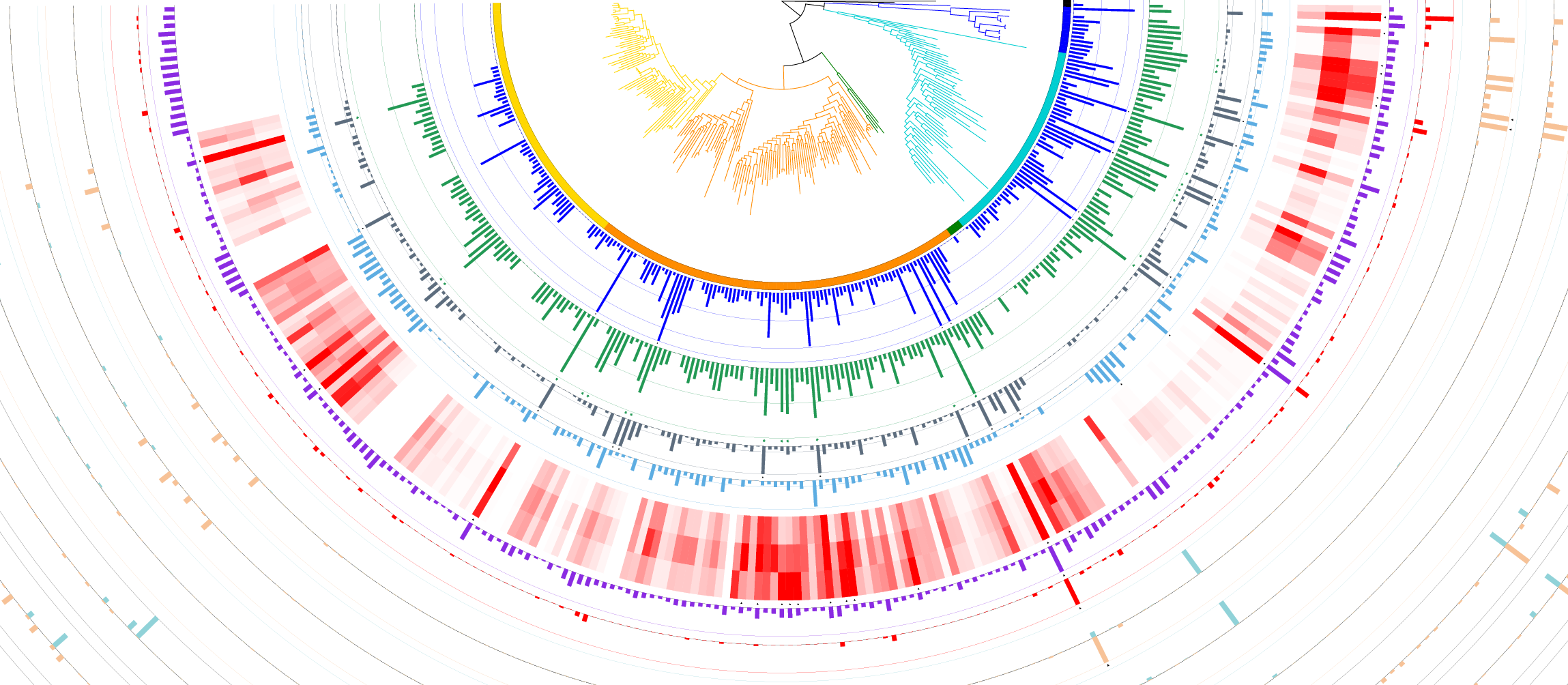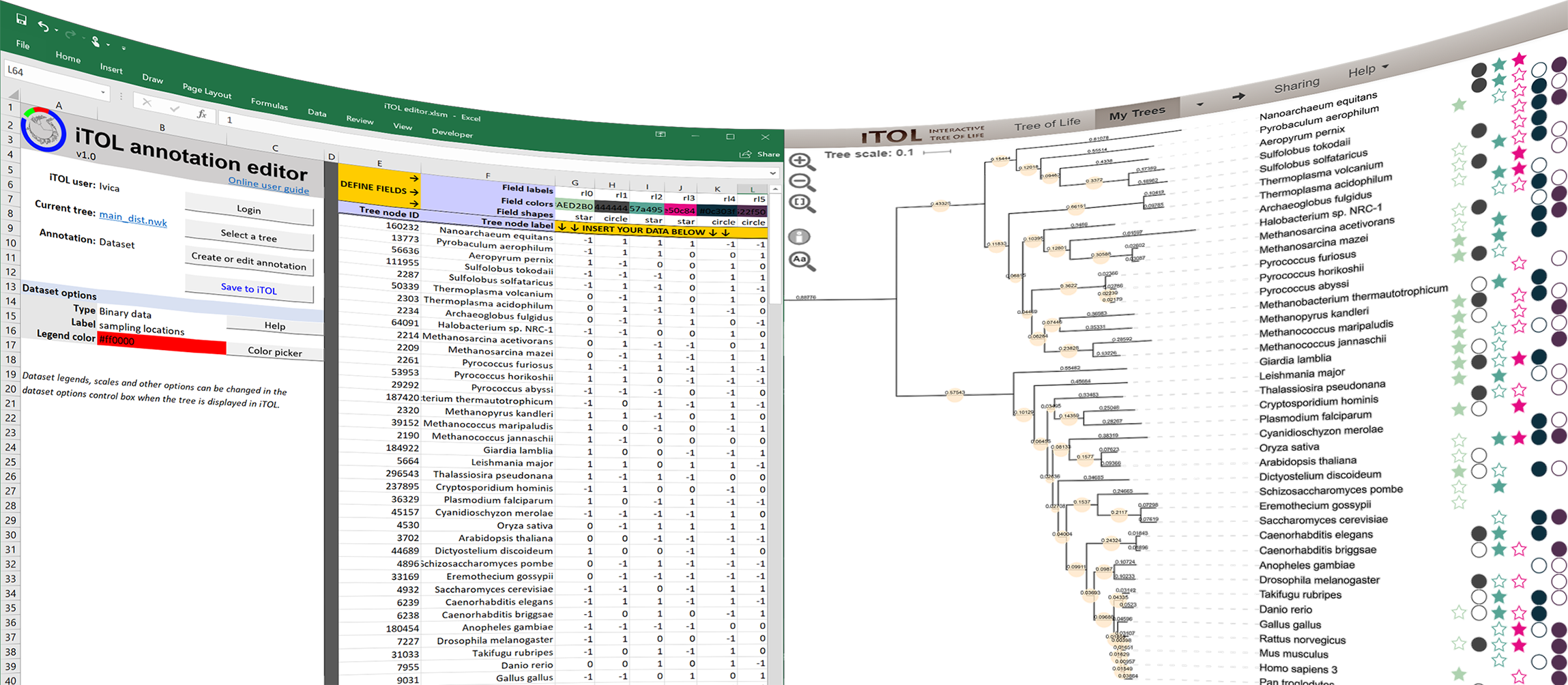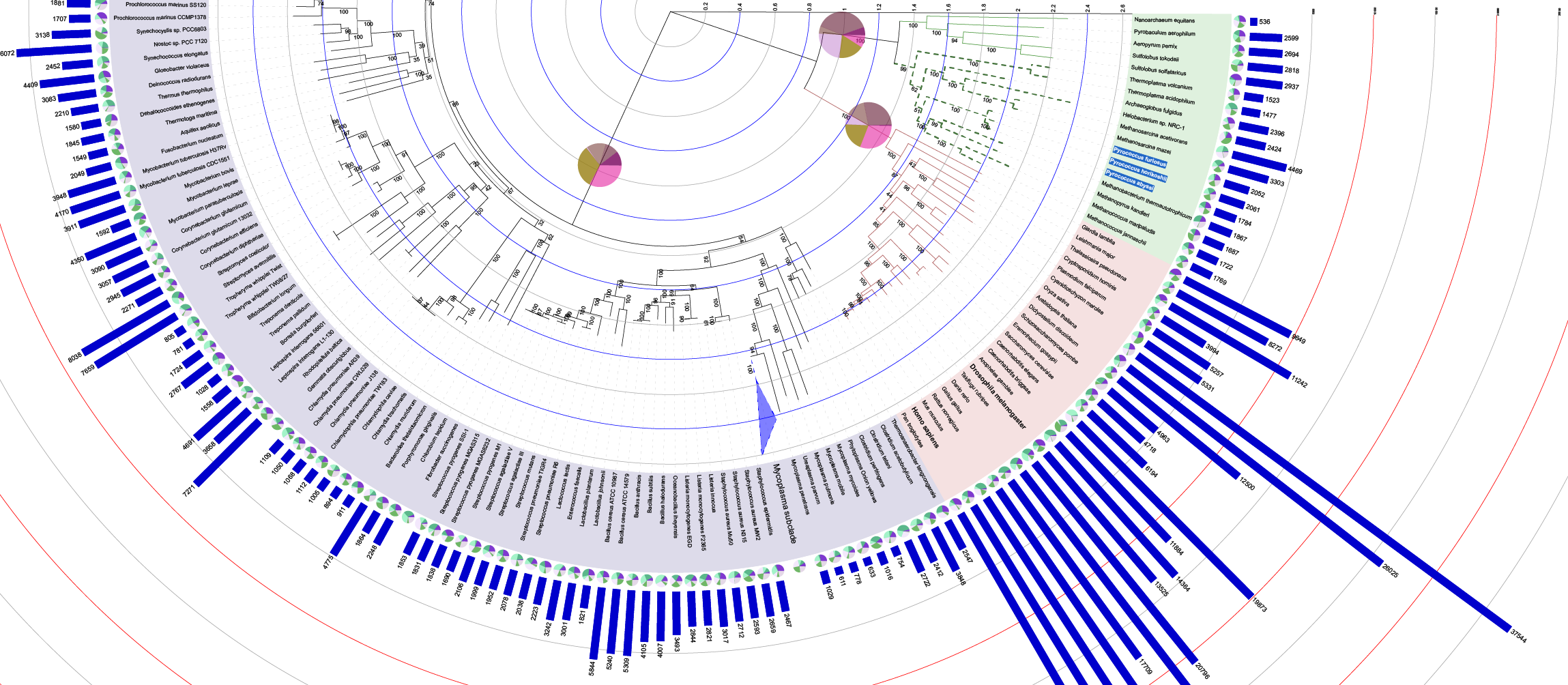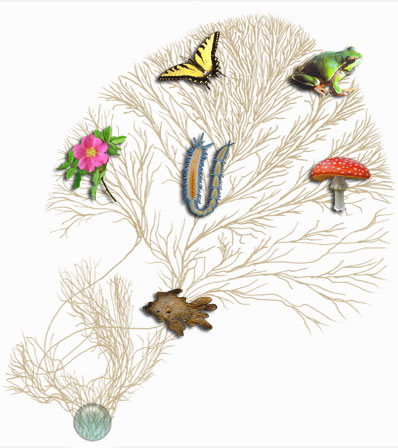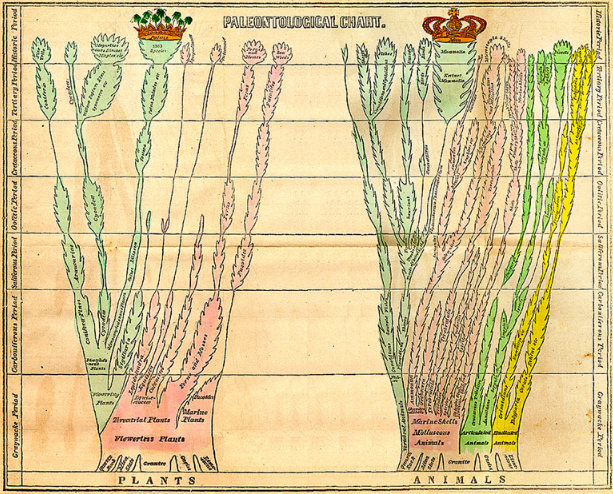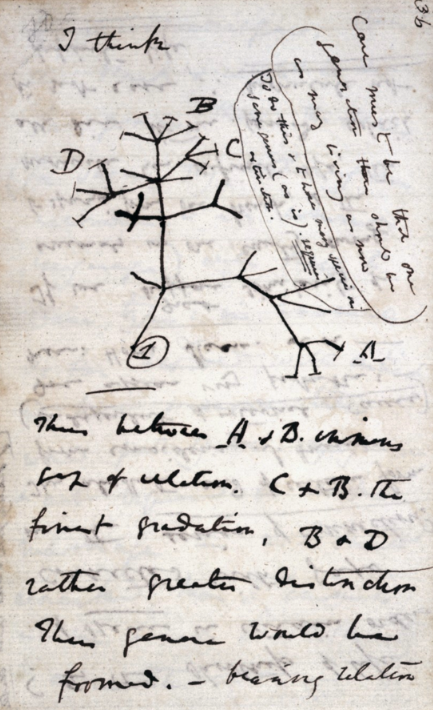Tree of life дерево
Lifemap is an interactive tool to explore the tree of life. The concept used in Lifemap is similar to the one used in cartography with tools like Google Maps© or Open Street Maps: exploring is done by zooming and panning.
The current tree contains 802639 species: 3733 Archaea, 277426 Bacteria and 521480 Eukaryotes. It is based on the taxonomy publised by the NCBI and updated regularly.
All the nodes in the tree are clickable. It displays information (description and picture) concerning the taxa (retrieved from the ikipedia page, if any). If you have description or pictures you would like to see in Lifemap, simply create or update the corresponding ikipedia page.
Itineraries between taxa can be computed by clicking on the icon on the left of the search field. When filling the two new search fields, the route is drawn between the taxa and the Most Recent Common Ancestor (MRCA) of the two groups/species is returned. The user gets also access to a list of all the nodes that are encountered in the way from one group to the other. This list is clickable.
‘Expert’ versions of Lifemap, dedicated to the researchers in genomics, genetics and evolutionary biology also exist. Lifemap-ncbi displays the entire NCBI taxonomy (more than 1.1 million taxa) and allows (i) an easy access to NCBI web pages, (ii) the visualization and count of genomes completely sequenced and (iii) the possibility to download every subtree for every node in Newick format. Lifemap-otol allows exploring the whole tree produced by the ‘Open Tree of Life’ project (around 2.2 Million species). Again, it allows easy access to other taxonomic resources at each node, and the possibility to download every subtree in Newick format.
Lifemap was written by Damien M. de Vienne (web page), a CNRS researcher working in the Laboratory of Biometry and Evolutionary Biology (LBBE) in Lyon (France) with support from the informatics departement (especially Stephane Delmotte and Bruno Spataro).
For any question, remark, suggestion, or bug report, please contact Damien de Vienne: damien.de-vienne@univ-lyon1.fr
Lifemap by Damien de Vienne / CNRS is licensed under a Creative Commons Attribution-NonCommercial 4.0 International License.
Источник
Welcome to iTOL v6
Interactive Tree Of Life is an online tool for the display, annotation and management of phylogenetic and other trees.
Manage and visualize your trees directly in the browser, and annotate them with various datasets.
Tree annotation made easy.
Annotate your trees directly from Microsoft Excel, LibreOffice or Google Sheets, or use the integrated web dataset editor. Advanced users can create the dataset template files and drag/drop them directly onto the tree, with complete control of all visualization options.
Adjust branch and label colors, styles and fonts interactively or by using annotation template files.
Unlimited number of datasets.
All datasets can be be displayed simultaneously, with fine-grained interactive control of their position, size and other visualization parameters.
Create publication quality figures.
iTOL provides What-You-See-Is-What-You-Get high quality export into several vector and bitmap graphics formats. Interactively adjust all tree and dataset visualization options as you like, and the exported figure will exactly mirror your screen.
Источник
Tree of Life Web Project
The Agaricales, or euagarics clade, is a monophyletic group of approximately 8500 mushroom species. read more
The Tree of Life Web Project (ToL) is a collaborative effort of biologists and nature enthusiasts from around the world. On more than 10,000 World Wide Web pages, the project provides information about biodiversity, the characteristics of different groups of organisms, and their evolutionary history (phylogeny).
Each page contains information about a particular group, e.g., salamanders, segmented worms, phlox flowers, tyrannosaurs, euglenids, Heliconius butterflies, club fungi, or the vampire squid. ToL pages are linked one to another hierarchically, in the form of the evolutionary tree of life. Starting with the root of all Life on Earth and moving out along diverging branches to individual species, the structure of the ToL project thus illustrates the genetic connections between all living things.
«The affinities of all the beings of the same class have sometimes been represented by a great tree. As buds give rise by growth to fresh buds, and these if vigorous, branch out and overtop on all sides many a feebler branch, so by generation I believe it has been with the great Tree of Life, which fills with its dead and broken branches the crust of the earth, and covers the surface with its ever branching and beautiful ramifications.»
Tree of Life design, images, and icons copyright © 1995-2005 Tree of Life Web Project. All rights reserved.
Image of rose © 1999 Nick Kurzenko. Image of annelid worm © 2001 Greg W. Rouse.
Источник
Tree of life дерево
Contributor MDPI registered users’ name will be linked to their SciProfiles pages. To register with us, please refer to https://encyclopedia.pub/register :
1. Early Natural Classification
Although tree-like diagrams have long been used to organize knowledge, and although branching diagrams known as claves («keys») were omnipresent in eighteenth-century natural history, it appears that the earliest tree diagram of natural order was the 1801 «Arbre botanique» (Botanical Tree) of the French schoolteacher and Catholic priest Augustin Augier. [1] [2] Yet, although Augier discussed his tree in distinctly genealogical terms, and although his design clearly mimicked the visual conventions of a contemporary family tree, his tree did not include any evolutionary or temporal aspect. Consistent with Augier’s priestly vocation, the Botanical Tree showed rather the perfect order of nature as instituted by God at the moment of Creation. [3]
In 1809, Augier’s more famous compatriot Jean-Baptiste Lamarck (1744–1829), who was acquainted with Augier’s «Botanical Tree», [4] included a branching diagram of animal species in his Philosophie zoologique. [5] Unlike Augier, however, Lamarck did not discuss his diagram in terms of a genealogy or a tree, but instead named it a tableau («depiction»). [6] Lamarck believed in the transmutation of life forms, but he did not believe in common descent; instead he believed that life developed in parallel lineages advancing from more simple to more complex. [7]
In 1840, the American geologist Edward Hitchcock (1793–1864) published the first tree-like paleontology chart in his Elementary Geology, with two separate trees for the plants and the animals. These are crowned (graphically) with the Palms and Man. [8]
The first edition of Robert Chambers’ Vestiges of the Natural History of Creation, published anonymously in 1844 in England, contained a tree-like diagram in the chapter «Hypothesis of the development of the vegetable and animal kingdoms». [9] It shows a model of embryological development where fish (F), reptiles (R), and birds (B) represent branches from a path leading to mammals (M). In the text this branching tree idea is tentatively applied to the history of life on earth: «there may be branching». [10]
In 1858, a year before Darwin’s Origin, the paleontologist Heinrich Georg Bronn (1800–1862) published a hypothetical tree labeled with letters. [11] Although not a creationist, Bronn did not propose a mechanism of change. [12]
2. Model of Evolution
2.1. Darwin
Charles Darwin (1809–1882) used the metaphor of a «tree of life» to conceptualize his theory of evolution. In On the Origin of Species (1859) he presented an abstract diagram of a theoretical tree of life for species of an unnamed large genus (see figure). On the horizontal base line hypothetical species within this genus are labelled A – L and are spaced irregularly to indicate how distinct they are from each other, and are above broken lines at various angles suggesting that they have diverged from one or more common ancestors. On the vertical axis divisions labelled I – XIV each represent a thousand generations. From A, diverging lines show branching descent producing new varieties, some of which become extinct, so that after ten thousand generations descendants of A have become distinct new varieties or even sub-species a 10 , f 10 , and m 10 . Similarly, the descendants of I have diversified to become the new varieties w 10 and z 10 . The process is extrapolated for a further four thousand generations so that the descendants of A and I become fourteen new species labelled a 14 to z 14 . While F has continued for fourteen thousand generations relatively unchanged, species B,C,D,E,G,H,K and L have gone extinct. In Darwin’s own words: «Thus the small differences distinguishing varieties of the same species, will steadily tend to increase till they come to equal the greater differences between species of the same genus, or even of distinct genera.» [13] This is a branching pattern with no names given to species, unlike the more linear tree Ernst Haeckel made years later (figure below) which includes the names of species and shows a more linear development from «lower» to «higher» species. In his summary to the section, Darwin put his concept in terms of the metaphor of the tree of life:
The affinities of all the beings of the same class have sometimes been represented by a great tree. I believe this simile largely speaks the truth. The green and budding twigs may represent existing species; and those produced during each former year may represent the long succession of extinct species. At each period of growth all the growing twigs have tried to branch out on all sides, and to overtop and kill the surrounding twigs and branches, in the same manner as species and groups of species have tried to overmaster other species in the great battle for life. The limbs divided into great branches, and these into lesser and lesser branches, were themselves once, when the tree was small, budding twigs; and this connexion of the former and present buds by ramifying branches may well represent the classification of all extinct and living species in groups subordinate to groups. Of the many twigs which flourished when the tree was a mere bush, only two or three, now grown into great branches, yet survive and bear all the other branches; so with the species which lived during long-past geological periods, very few now have living and modified descendants. From the first growth of the tree, many a limb and branch has decayed and dropped off; and these lost branches of various sizes may represent those whole orders, families, and genera which have now no living representatives, and which are known to us only from having been found in a fossil state. As we here and there see a thin straggling branch springing from a fork low down in a tree, and which by some chance has been favoured and is still alive on its summit, so we occasionally see an animal like the Ornithorhynchus or Lepidosiren, which in some small degree connects by its affinities two large branches of life, and which has apparently been saved from fatal competition by having inhabited a protected station. As buds give rise by growth to fresh buds, and these, if vigorous, branch out and overtop on all sides many a feebler branch, so by generation I believe it has been with the great Tree of Life, which fills with its dead and broken branches the crust of the earth, and covers the surface with its ever branching and beautiful ramifications.
The meaning and importance of Darwin’s use of the tree of life metaphor have been extensively discussed by scientists and scholars. Stephen Jay Gould, for one, has argued that Darwin placed the famous passage quoted above «at a crucial spot in his text», where it marked the conclusion of his argument for natural selection, illustrating both the interconnectedness by descent of organisms as well as their success and failure in the history of life. [15] David Penny has written that Darwin did not use the tree of life to describe the relationship between groups of organisms, but to suggest that, as with branches in a living tree, lineages of species competed with and supplanted one another. [16] Petter Hellström has argued that Darwin consciously named his tree after the biblical Tree of Life, as described in Genesis, thus relating his theory to the religious tradition. [6]
Page from Darwin’s notebooks c. July 1837 with his first sketch of an evolutionary tree, and the words «I think» at the top
Источник
